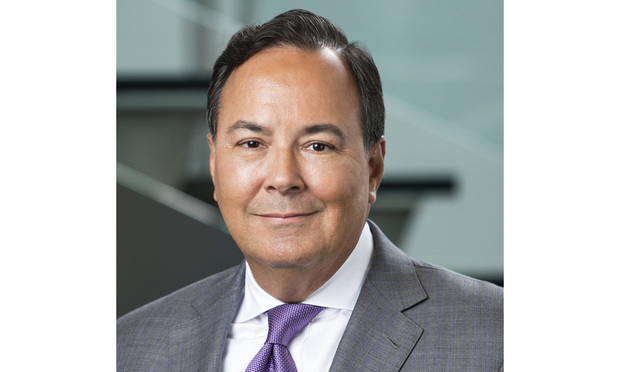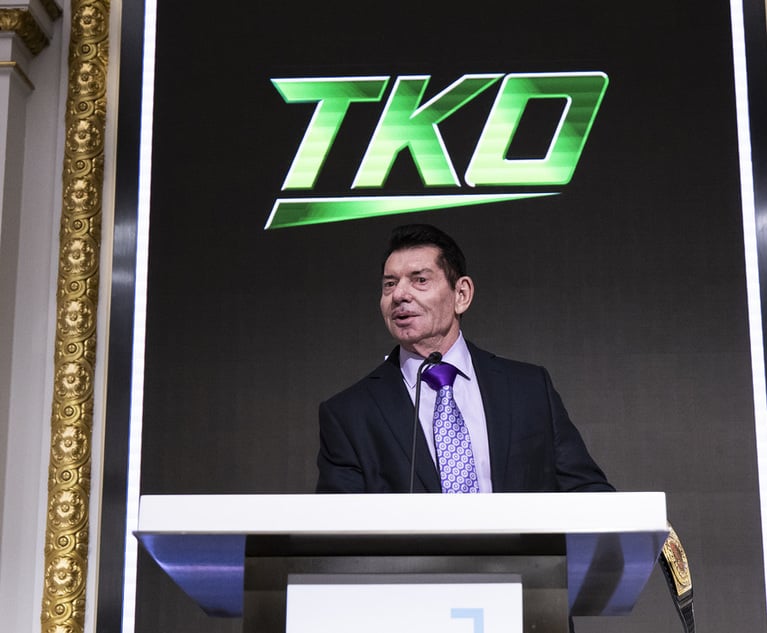Nasdaq: A Group Effort in Legal
While the company has its own in-house legal team of roughly 100 lawyers, Nasdaq uses outside counsel for complex litigation and transactional matters.
October 25, 2017 at 07:31 PM
10 minute read
 Edward Knight, executive vice president and GC of Nasdaq.
Edward Knight, executive vice president and GC of Nasdaq. As might be expected, Edward Knight, the executive vice president and GC at Nasdaq, has lots of friends at law firms.
Before joining Nasdaq in 1999, Knight was a partner at Akin Gump Strauss Hauer & Feld and served as the general counsel of the U.S. Department of the Treasury. But when it comes time to pick outside counsel at Nasdaq, he doesn't rely on the coterie of attorneys he's befriended through the years—he leaves those choices to a committee.
Read more: Who Represents America's Biggest Companies?
Roughly two years ago, Nasdaq created a committee of roughly a dozen in-house http://www.law.com/corpcounsel/sites/corpcounsel/?p=2127&preview=trueattorneys to consider outside counsel, according to Knight.
“A lot of times we weren't retaining that many law firms, so it wasn't something that we needed to form a process on,” Knight says. “But as the company is getting bigger, we decided that we wanted to have a more firm process. The amount of money being spent is not insignificant. We wanted transparency on decisions. I have a lot of friends in law firms. I spent 14 years myself at a private law firm,” he adds. “I wanted to make sure we removed any subjectivity from decision-making.”
While the company has its own in-house legal team of roughly 100 lawyers, Nasdaq uses outside counsel for complex litigation and transactional matters. Law firms are selected either by the committee of lawyers at Nasdaq or through a request for proposals, more commonly referred to as an RFP, which solicits proposals through a law firm bidding process. Nasdaq primarily uses RFPs in “areas where we have more paperwork,” Knight says.
“There's the litigation area and transactions, those are two big areas for a public company,” he says. “We have used both RFPs and also, once we have worked with firms that have been successful at litigation … then we will come back to them.”
So how does a massive company such as Nasdaq, which lists more than 3,600 companies with a total market value of $9.6 trillion and has more than 10,000 corporate clients who purchase Nasdaq's corporate products, handle it's legal bills? It uses the internet. Nasdaq uses the electronic billing program formerly known as Serengeti Tracker, now known as Thomson Reuters Legal Tracker. The web-based software is used by hundreds of law departments to manage their invoices, budgets and documents from outside firms.
While Knight declined to say which law firms the second-largest stock exchange most often retains as outside counsel, it's clear that when Nasdaq likes a firm's work, it will continue the relationship. “We feel that understanding is absolutely critical. We're looking for a certain result, and if they get results, we feel like we owe it to the firms that are involved [and] we want to continue to work with them,” Knight says.
When choosing a firm to work with, the committee of lawyers at Nasdaq, which meets on a monthly basis, looks to firms that can handle and “understand the uniqueness at Nasdaq,” notes Knight, but the committee also puts a premium on firms that have a diversity program.
 Edward Knight, executive vice president and GC of Nasdaq.
Edward Knight, executive vice president and GC of Nasdaq. As might be expected, Edward Knight, the executive vice president and GC at Nasdaq, has lots of friends at law firms.
Before joining Nasdaq in 1999, Knight was a partner at
Read more: Who Represents America's Biggest Companies?
Roughly two years ago, Nasdaq created a committee of roughly a dozen in-house http://www.law.com/corpcounsel/sites/corpcounsel/?p=2127&preview=trueattorneys to consider outside counsel, according to Knight.
“A lot of times we weren't retaining that many law firms, so it wasn't something that we needed to form a process on,” Knight says. “But as the company is getting bigger, we decided that we wanted to have a more firm process. The amount of money being spent is not insignificant. We wanted transparency on decisions. I have a lot of friends in law firms. I spent 14 years myself at a private law firm,” he adds. “I wanted to make sure we removed any subjectivity from decision-making.”
While the company has its own in-house legal team of roughly 100 lawyers, Nasdaq uses outside counsel for complex litigation and transactional matters. Law firms are selected either by the committee of lawyers at Nasdaq or through a request for proposals, more commonly referred to as an RFP, which solicits proposals through a law firm bidding process. Nasdaq primarily uses RFPs in “areas where we have more paperwork,” Knight says.
“There's the litigation area and transactions, those are two big areas for a public company,” he says. “We have used both RFPs and also, once we have worked with firms that have been successful at litigation … then we will come back to them.”
So how does a massive company such as Nasdaq, which lists more than 3,600 companies with a total market value of $9.6 trillion and has more than 10,000 corporate clients who purchase Nasdaq's corporate products, handle it's legal bills? It uses the internet. Nasdaq uses the electronic billing program formerly known as Serengeti Tracker, now known as Thomson Reuters Legal Tracker. The web-based software is used by hundreds of law departments to manage their invoices, budgets and documents from outside firms.
While Knight declined to say which law firms the second-largest stock exchange most often retains as outside counsel, it's clear that when Nasdaq likes a firm's work, it will continue the relationship. “We feel that understanding is absolutely critical. We're looking for a certain result, and if they get results, we feel like we owe it to the firms that are involved [and] we want to continue to work with them,” Knight says.
When choosing a firm to work with, the committee of lawyers at Nasdaq, which meets on a monthly basis, looks to firms that can handle and “understand the uniqueness at Nasdaq,” notes Knight, but the committee also puts a premium on firms that have a diversity program.
This content has been archived. It is available through our partners, LexisNexis® and Bloomberg Law.
To view this content, please continue to their sites.
Not a Lexis Subscriber?
Subscribe Now
Not a Bloomberg Law Subscriber?
Subscribe Now
NOT FOR REPRINT
© 2025 ALM Global, LLC, All Rights Reserved. Request academic re-use from www.copyright.com. All other uses, submit a request to [email protected]. For more information visit Asset & Logo Licensing.
You Might Like
View All
SEC Puts Beat Down on Ex-Wrestling CEO Vince McMahon for Not Reporting Settlements
3 minute read
After Solving Problems for Presidents, Ron Klain Now Applying Legal Prowess to Helping Airbnb Overturn NYC Ban
7 minute read
Legal Departments Dinged for Acquiescing to Rate Hikes That 'Defy Gravity'
4 minute read
DLA Piper Adds Former Verizon GC Amid In-House Hiring Spree
Trending Stories
- 1'It's Not Going to Be Pretty': PayPal, Capital One Face Novel Class Actions Over 'Poaching' Commissions Owed Influencers
- 211th Circuit Rejects Trump's Emergency Request as DOJ Prepares to Release Special Counsel's Final Report
- 3Supreme Court Takes Up Challenge to ACA Task Force
- 4'Tragedy of Unspeakable Proportions:' Could Edison, DWP, Face Lawsuits Over LA Wildfires?
- 5Meta Pulls Plug on DEI Programs
Who Got The Work
Michael G. Bongiorno, Andrew Scott Dulberg and Elizabeth E. Driscoll from Wilmer Cutler Pickering Hale and Dorr have stepped in to represent Symbotic Inc., an A.I.-enabled technology platform that focuses on increasing supply chain efficiency, and other defendants in a pending shareholder derivative lawsuit. The case, filed Oct. 2 in Massachusetts District Court by the Brown Law Firm on behalf of Stephen Austen, accuses certain officers and directors of misleading investors in regard to Symbotic's potential for margin growth by failing to disclose that the company was not equipped to timely deploy its systems or manage expenses through project delays. The case, assigned to U.S. District Judge Nathaniel M. Gorton, is 1:24-cv-12522, Austen v. Cohen et al.
Who Got The Work
Edmund Polubinski and Marie Killmond of Davis Polk & Wardwell have entered appearances for data platform software development company MongoDB and other defendants in a pending shareholder derivative lawsuit. The action, filed Oct. 7 in New York Southern District Court by the Brown Law Firm, accuses the company's directors and/or officers of falsely expressing confidence in the company’s restructuring of its sales incentive plan and downplaying the severity of decreases in its upfront commitments. The case is 1:24-cv-07594, Roy v. Ittycheria et al.
Who Got The Work
Amy O. Bruchs and Kurt F. Ellison of Michael Best & Friedrich have entered appearances for Epic Systems Corp. in a pending employment discrimination lawsuit. The suit was filed Sept. 7 in Wisconsin Western District Court by Levine Eisberner LLC and Siri & Glimstad on behalf of a project manager who claims that he was wrongfully terminated after applying for a religious exemption to the defendant's COVID-19 vaccine mandate. The case, assigned to U.S. Magistrate Judge Anita Marie Boor, is 3:24-cv-00630, Secker, Nathan v. Epic Systems Corporation.
Who Got The Work
David X. Sullivan, Thomas J. Finn and Gregory A. Hall from McCarter & English have entered appearances for Sunrun Installation Services in a pending civil rights lawsuit. The complaint was filed Sept. 4 in Connecticut District Court by attorney Robert M. Berke on behalf of former employee George Edward Steins, who was arrested and charged with employing an unregistered home improvement salesperson. The complaint alleges that had Sunrun informed the Connecticut Department of Consumer Protection that the plaintiff's employment had ended in 2017 and that he no longer held Sunrun's home improvement contractor license, he would not have been hit with charges, which were dismissed in May 2024. The case, assigned to U.S. District Judge Jeffrey A. Meyer, is 3:24-cv-01423, Steins v. Sunrun, Inc. et al.
Who Got The Work
Greenberg Traurig shareholder Joshua L. Raskin has entered an appearance for boohoo.com UK Ltd. in a pending patent infringement lawsuit. The suit, filed Sept. 3 in Texas Eastern District Court by Rozier Hardt McDonough on behalf of Alto Dynamics, asserts five patents related to an online shopping platform. The case, assigned to U.S. District Judge Rodney Gilstrap, is 2:24-cv-00719, Alto Dynamics, LLC v. boohoo.com UK Limited.
Featured Firms
Law Offices of Gary Martin Hays & Associates, P.C.
(470) 294-1674
Law Offices of Mark E. Salomone
(857) 444-6468
Smith & Hassler
(713) 739-1250






